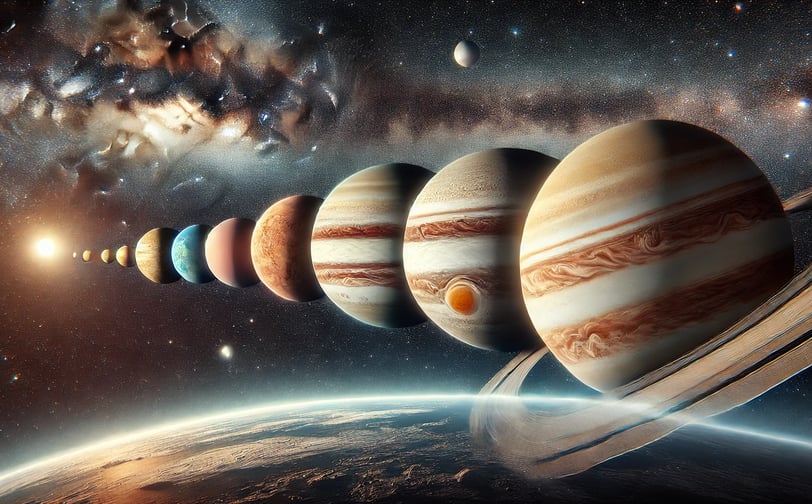Planetary Alignment: Phenomenon, Impacts, and History
A planetary alignment occurs when multiple planets in the Solar System appear to be arranged in a straight line or an approximate configuration from a specific point of reference, such as Earth. This can involve a small group of planets or all known planets in the solar system.
2/25/20252 min read


There are different types of alignments, including:
Conjunction: When two or more planets appear close together in the sky.
Partial alignment: When three or more planets cluster in a specific region.
Grand alignment: When several planets are nearly aligned relative to the Sun.
Effects on Planets and Their Moons
The gravitational influence of planets on each other is real but generally too small to cause significant disturbances. However, in rare alignments involving large planets like Jupiter and Saturn, small orbital variations may occur over millennia.
The moons of planets may experience subtle changes in their orbits due to gravitational resonance, but without any immediate perceptible effects.
Influence on Tides
On Earth, tides are primarily influenced by the Moon and, to a lesser extent, by the Sun. When an alignment involving the Sun, Moon, and Earth occurs (such as during full and new moons), tides become more intense, known as spring tides. However, planetary alignments that do not involve the Moon have almost no effect on Earth's tides, as the gravitational influence of distant planets is negligible.
Relationship with Volcanoes and Earthquakes
Some theories suggest that planetary alignments could increase volcanic and seismic activity due to additional gravitational forces. However, scientific studies have not found any statistically significant correlation between planetary alignments and geological events on Earth. The movement of tectonic plates is primarily governed by Earth's internal heat and local geological dynamics.
Possible Impacts on Climate
So far, there is no scientific evidence that planetary alignments directly impact Earth's climate. Earth's climate is influenced by factors such as solar radiation, atmospheric composition, and oceanic patterns, not by the gravitational effects of planets.
Historical Alignments and Their Events
Several planetary alignments have been recorded throughout history. Some examples include:
February 5, 1962: A major planetary alignment involving the Sun, Moon, Mercury, Venus, Mars, Jupiter, and Saturn occurred. Some apocalyptic predictions were made, but nothing out of the ordinary happened.
March 10, 1982: The alignment known as the "Jupiter Effect," proposed by some scientists, predicted that the gravitational pull of the aligned planets could cause major earthquakes on Earth. However, no significant seismic correlation was observed.
July 4, 2020: An alignment involving six planets took place, with no detectable effects on Earth.
February 28, 2025: A significant planetary alignment is expected on this date. While scientists state that the event will be visually impressive, there is no evidence to suggest any relevant geophysical impact. On the other hand, pseudoscience theorists speculate about possible influences on earthquakes, volcanic eruptions, and climate changes, but these hypotheses lack empirical support.
Conclusion
Planetary alignments are fascinating astronomical events that occur periodically and predictably. While they can generate stronger tides when involving the Moon, there is no scientific evidence that they significantly impact volcanoes, earthquakes, or Earth's climate. These phenomena continue to be subjects of study and observation for astronomers and science enthusiasts.
Explore
Discover diverse topics in one convenient hub.
Connect
Learn
contact@mindstormblog.com
© 2025. All rights reserved.


